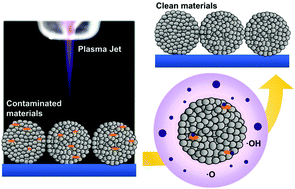A new approach to surface activation of porous nanomaterials using non-thermal helium atmospheric pressure plasma jet treatment†
Abstract
Non-thermal helium atmospheric pressure plasma jet treatment is applied to the surface activation of porous TiO2 nanoparticle assemblies. Treatment conditions such as the working distance of the plasma discharge, helium gas flow rate, and treatment time are optimized for effective removal of contaminants from the assembly surface. Laser desorption/ionization time-of-flight mass spectrometry (LDI-TOF MS) is applied to detect trace amounts of contaminants on assembly surfaces. Scanning electron microscopy (SEM) and transmission electron microscopy (TEM) observations confirm that the nanoparticle assemblies retain their original perfect spherical structures as well as their ultra-fine convex–concave nano-surfaces even after the plasma jet treatment. N2 adsorption/desorption and X-ray diffraction (XRD) measurements show no significant changes in their BET specific surface areas and crystal structures, respectively. The plasma jet-treated TiO2 nanoparticle assemblies show a 3.8 fold improvement in their reaction rate constants for methylene blue degradation and a 2 fold enhancement of their photocurrents under UV irradiation when compared with untreated TiO2.



 Please wait while we load your content...
Please wait while we load your content...